Estimated reading time: 21 minutes.
May/2016 - Fujifilm is one of the oldest companies grounded in photography. Founded in 1937 as the first local film manufacturer in Japan, it was the soul inside every Canon or Nikon camera, that otherwise would use imported negatives from its american rival Kodak. For the whole 20th century, you either bought the green Fujifilm cartridge, or the yellow Kodak one. Camera and lenses on the other hand, came from bigger german or japanese companies, known for their optical specialty.

Jump ahead to the millennium and its electronic images. How could a film based company remain relevant on a digital market? In 1988 Fuji launched the Fujix DS 1P, the world’s first digital camera as we know and use today, with a removable memory card and true digital capture. With a 400 kilopixels sensor and a 2MB memory card, it was the future of cameras as we know it, a hint that things were about to change and a bet that Fuji couldn’t miss. While Kodak went bankrupt for failing to adapt, Fuji took the leap of faith at the technology development and triumphed.

Fujifilm’s FUJIX DS-1P, the world’s first all-digital photography camera, with a removable memory card like the ones we use today. [source: Fujifilm]
They tried with CCDs, Super CCD, HR, SR, SR II, EXR… All attempts to simulate on a silicon imager the same color and exposure latitude of film. While virtually all today’s cameras use a CMOS sensor with a Bayer color arrangement, the one that suffers from moiré and requires a low pass filter to avoid aliasing, only a traditional film company could think outside the box. Their most recent technology is called X-Trans, a novelty color array that promises to link the old school Fujifilm with the next era of high end digital cameras. It’s the heart of all recent X models.

A traditional image sensor used three layers: one with the wiring and light sensitive diodes, that measure the amount of photons that fall onto it; a second layer painted with colors, normally a Bayer array that proposes a four pixel pattern (two green, one blue and one red) to mathematically represent the colors after a process called demosaicing; and a third low pass filter that must blur the light over the diodes to avoid absolute values, that generate fake colors on manmade patterns, an issue called moiré. Your camera probably has one of these sensors, but Fuji did differently.

On Fuji’s X-Trans sensor, a new color pattern is used. With astonishing 36 pixels, 20 greens, 8 reds and 8 blues over a much more complex repetition, it’s possible to minimize the moiré occurrence, enhance color density (every row reads both color values) and also increase resolution, keeping the same number of pixels. With less moiré, the blurring low pass filter is unnecessary, for even sharper images. It’s the foundation to most Fuji X’s, and the tech you’ll want in your next digital camera.

The X-Pro 2 is Fuji’s latest creation around the X-Trans sensor. A mirrorless camera with a vintage appeal, it’s not only a hipster dream with all-mechanical dials and retro look, but a different shooting philosophy borrowed from Leica’s rangefinders. Instead of an optical viewfinder on the same light path as the lens mount, the X-Pro has a reversed Galileo viewfinder allocated to the left, wide and bright, with old school parallax error. But in spite of the traditional Leica appeal, the X-Pro 2 is a giant leap into the future, with 77 phase detection auto focusing points, 1080P60 video, up to 8 frames per second full resolution shooting, and a hybrid viewfinder with a built-in LCD.

Finally one of the most requested cameras on vlog do zack. And I have just one thing to say: I’m in love with it. I’ve never cared for Fuji and always questioned the X-Trans value, opposed to Sigma’s attempt on novelty sensors like the flawed X3 Foveon. But after a week using the X-Pro 2 on a road trip, I was left with the same photographic connection I experienced with the Canon 5D Mark II in 2010, one of the most iconic cameras ever. But one thing is for sure: the X-Pro isn’t traditional, and it probably won’t work for most photographers. Will it work for you? Let’s find out! Nice reading.

At 14 x 8.3 x 4.5 cm of 498g, the first impression left by Fuji’s X-Pro 2 is its size, gigantic for the APS-C mirrorless market. Tall, long and thick, it’s very different from Sony’s or Micro Four Thirds camera ideals, meant to be compact against traditional DSLRs. Actually Fujifilm sports various format on the X lineup, and the X-Pro follows the rangefinder style, with an optical viewfinder misaligned to the lens mount. And honestly that’s the only purchasing decision you’ll have to make: you either want a camera like this or not. Except for Leica, no other brand offers a digital rangefinder.

The “rangefinder style” advantage is more psychological than practical. For the photographer, the X-Pro 2 looks like a camera above all, taking all distractions away leaving a single expectation about it: to use as a photographic tool. Some people take a A6300 in hands and don’t know what to do first: to take a picture or to record a video? Adding to that, to the subject the rangefinder is also more personal: the camera doesn’t cover the photographers face, and they communicate better. Candid moments are more likely to happen, and that’s the rangefinder appeal still today.

“Self portrait” with the XF 35mm f/2 R WR at f/2 1/60 ISO500; notice how a “rangefinder styled” camera covers less of the photographers face.
In practice the X-Pro 2 balances on your right hand thumb and middle fingers, impossible to used on a singe hand operation. As the right hand supports the camera, you must free it’s fingers to operate the buttons, using the left hand. So with both hands in place, cushioning the camera underneath, it is possible to use it comfortably. For instance both horizontal dials hidden inside the camera, the rear dial must be used with a twisted thumb, and the front dial requires the index finger, demanding the left hand counter balance. Even the AF-L and Q buttons are behind the rear thumb grip, meant to be used with the camera between hands. It feels great, not too light, not too heavy.
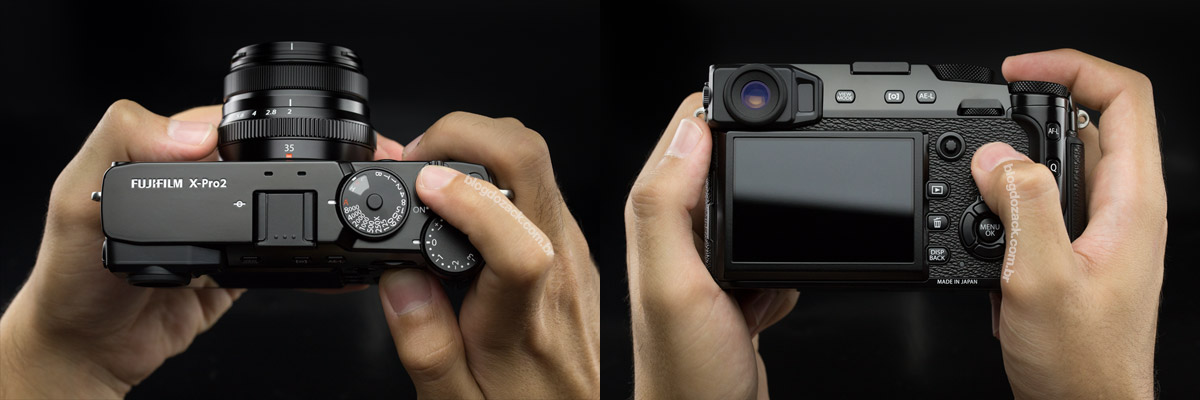
Operational highlights are its mechanical dials at the top, the rear thumb stick and the viewfinder selection lever at the front. Both dials are part of Fuji’s “retro look”: one at the right corner for exposure compensation, and another at the top that double as a shutter speed and ISO control. The shutter speed is straight forward: release the dial with the center button lock and spin it from 1/8000 to bulb in full stops; further 1/3 stops adjustments must be made electronically. And the ISO dial is Fuji’s hipster dream: you must raise the external shutter speed dial ring, and turn it to select the ISO value. It’s cumbersome as this ring feels fragile and disconnected from the camera. If it wasn’t bad enough, you have to stop EVERYTHING to actually see the value input. It needs getting used to.

The ISO dial (left) is inside the shutter speed dial, accessed by raising the external dial ring. The EV dial has a C position for electronic adjustments.
The rear thumb joystick is the first ever on a Fuji X. Identical to Canon’s top DSLRs control, it even shares the same function: to quickly select an auto focusing point, that are many on the X-Pro 2. It’s a very intuitive control that all cameras should have (take a hint, Sony…). Look inside the viewfinder, point the camera at your subject, move the focusing point with your thumb; shoot with the index finger. It’s so easy that I forgive the lack of touch screen on cameras sporting a joystick. And at the front there’s another intuitive control in the form of an index finger lever: pull into your hands to cycle between OVF or EVF viewfinder modes; push towards the lens to activate the Electronic Rangefinder mode (ERF). At the center there’s a depth of field preview button.

Viewfinder mode selection lever (left) at the front, despite its design, it turns both ways. AF point thumb stick (right) it tiny but very ergonomic.
The rest is a button plethora that might seem counter intuitive for those coming from a DSLR. From right to left, behind the thumb rear grip are AF-L (auto focus lock) and Q (quick menu), that are more ergonomic on Canon cameras. Next to the LCD screen are playback buttons, including delete (trash) and DISP/BACK; unfortunately there’s no dedicated MENU button. It’s instead inside the four button directional controls together with the OK button, which is kind of dumb: you press MENU to activate it, but can only leave by pressing the BACK button. Lost at the top are AE-L (auto exposure lock), metering mode (it’s a sub-dial on the X-T1) and the stupidest of all, “VIEW MODE”; it’s just a shortcut to de/activate the viewfinder auto sensor. It could be hidden inside the menus.
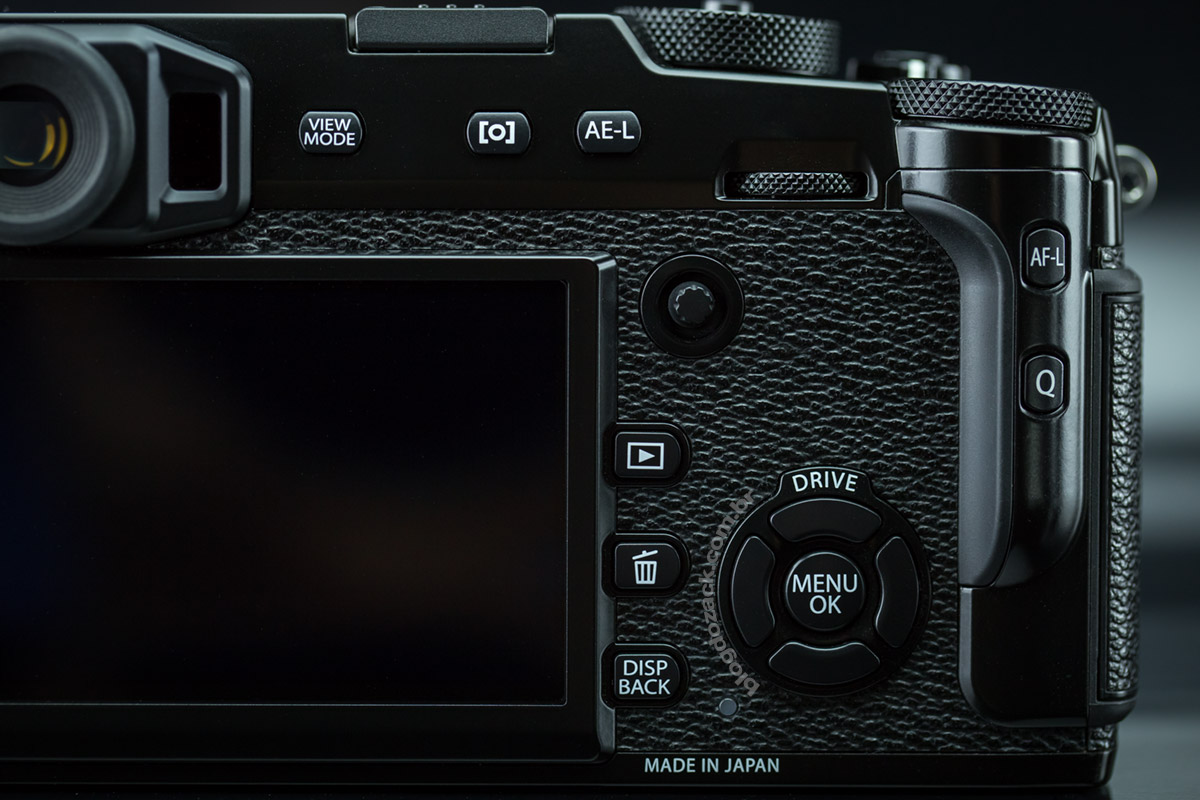
At the front there’s a focusing mode selection switch: single, continuous and manual. I don’t get its position on any camera, but manufactures insist it’s a good place to put it. As the ISO hipster dial, I must stop everything to actually see what I’m selecting on the AF DRIVE switch. Next to the shutter release there’s a Fn custom button. To your left are HDMI, USB2.0 and mic in plugs; all sitting behind a very cheap plastic cover. And to your right are dual SD card slots, the first ever on a mirrorless camera; the first slot is UHS-II compatible, all sitting behind another flimsy door.

Overall the Fuji X-Pro 2 is essentially different from anything we’ve ever seen on vlog do zack. It’s big for a mirrorless camera, has the exclusive “rangefinder style” and its controls are well placed, besides the both-hands-only operation. It’s well built from a magnesium alloy and there’s no moving parts, with 66 points of declared weather sealing (untested…). Fuji’s attempt to diversify the X lineup is welcomed on the saturated digital photography market, and the X-Pro 2 “photo oriented” appeal stands out from other functions. It’s worth those interested in nothing but photography.

The X-Pro 2 soul is its “shoulder” optical viewfinder, on a different path than the lens mount; similar to Leica’s M that use a rangefinder mechanism. On the german camera, a series of mirrors and prisms show an image overlay on top of the real optical viewfinder field of view, aimed at the photographers aid to focus the camera. When both images are aligned, the camera is in focus (the lens is set to the focal plane). It’s a complex mechanism that’s expensive to manufacture, partially explaining Leica’s ridiculous prices. From such system the “rangefinder style” is born, with the camera to the left of the photographers face, that Fuji copies on the X-Pro on a different implementation.

Leica M Typ 240 (left) [source: Leica] vs. Fujifilm X-Pro2: same overall style, completely different implementations, one half modern, other all electronic.
Besides the same reversed Galileo optical viewfinder on the camera shoulder, the X-Pro 2 doesn’t have a series of prisms to see the lens position. There’s actually an electronic LCD screen underneath the viewfinder, that can be seen at all times as an optical overlay, with two different modes: partial, with white frame markings and extra data; or fully visible, like an electronic viewfinder (EVF). It’s easy to understand: like a television teleprompter, the LCD image is reflected into the photographers eye, seeing both images (real and electronic) at all times. It’s the X-Pro 2 major selling point, offering three distinct shooting modes (OVF, EVF or LCD) all on a single camera.
![Por dentro do viewfinder da Fuji X-Pro 2: OVF híbrido, com overlay e função ERF; ou EVF nativo por LCD, tudo na mesma peça e ao giro de um botão. [créditos: Fujifilm]](http://blogdozack.com.br/wp-content/uploads/2016/05/ZPR-FUJI-X-PRO2-VF2.jpg)
Inside Fuji’s X-Pro 2 viewfinder: a hybrid OVF, with an electronic overlay; or native EVF, all on the same piece. [source: Fujifilm]
On the optical mode, this viewfinder is bright and clear, and of course, “real”. Colors are real, movements are real, and the field of view is wide, useful to frame your shot before the subject gets into the picture. As it’s a hybrid viewfinder (you can see the LCD overlay at all times), it’s possible to include extra data like variable guide frames (that changes from lens focal lengths), AF points and even a live histogram; impossible on a Leica rangefinder. There’s even an Electronic Rangefinder (ERF) mode that partially darkens the corners of the viewfinder, to display an enlarged focusing area. It’s all very clever and organic, justifying the X-Pro 2 purchase for this viewfinder itself.

On OVF mode, the viewfinder is bright and clear, in real time; the electronic overlay shows extra camera information like guide frames and histogram.
On EVF mode (electronic viewfinder), a mechanical cover shuts the optical piece allowing only the LCD screen to be visible. With 2.36million dots its sharpness is incredible, the same as Sony’s OLED Alphas. It’s a bit small at 0.59X magnification (the A6300 is 0.70X), but big enough with reasonable clear letters. As the image preview comes from the photographic sensor, the lens framing is 100% exact, eliminating the parallax error. So the EVF works best for extreme lenses (too wide or too long) that otherwise wouldn’t be as dramatic on the full optical mode. So the X-Pro 2 offers the same EVF experience from mirrorless cameras, with the novelty of a rangefinder viewfinder.

On EVF mode the sensor preview is an exact lens framing, with proper focusing and depth of field previews; the colors are unfortunately too electronic.
At the rear the 3” LCD screen is one of the best I’ve ever seen. Huge and sharp, its 1.6million dots are twice the panel of the A6300 we just saw. While the Sony 16:9 screen felt cheap, the X-Pro 2 looks better than most high end smartphones. Its colors are vibrant and there are adjustments for saturation and brightness; thing only cameras devoted to color reproduction are capable of. And it’s smart at the same 3:2 ratio as the image sensor, displaying a large live view feed with exposure data overlays. Although it’s not touch sensitive, I’ll let it pass as Fuji’s overall button layout do a great job to operate the camera. But it’s an idea for the next X-Pro 3 itineration.

Some anecdotes about the OVF usability. As the hybrid optical displays a reflection of the LCD screen as an overlay, when used with polarized glasses the image might disappear! It’s a thing I notice after purchasing and annoying for those who use glasses. If its lenses are polarized, the OVF overlay might not be visible. I doesn’t happen in full EVF mode, though. Another issue is about lens caps. As the OVF doesn’t show the same imager path, sometimes I forgot to remove the lens cap and there’s no warning on the OVF. As you can imagine, the images were not captured. My bad…
Another X-Pro 2 highlight is its speed, becoming standard on mirrorless cameras and not a DSLR pro anymore. Just to turn the switch ON and the X-Pro 2 is ready. It takes less than half a second to light up the rear LCD screen and shoot the first picture; it feels faster than even the speedy Sony A6300. You barely take your hands out of the ON/OFF rocker and the camera is ready to shoot. It’s excellent for street photography without leaving the camera ON at all times. And also when it’s time to shoot, the Fuji is a beast: there’s no lag between the button press and the shutter release; maybe one of the fastest cameras I’ve ever used (maybe the Canon 1D-X feels faster).

“Look” with the XF 35mm f/2 R WR at f/5.6 1/180 ISO200; point and shoot, with no lag to miss your subject’s expression.
But most impressively is the between shot interval: there’s none! Between the button press and the camera being ready for the next picture happens in the blink of an eye, very useful when you’re using an OVF that doesn’t show any blackout. It’s even impressive when shooting through the LCD screen: it barely blinks and the camera is ready, very fluidly. It’s point and shoot, shoot and shoot… Also it’s the first camera I’ve tested with UHS-II support, for up to 280MB/s writing speeds; more than twice the Sony A6300 or Canon EOS 7D Mark II. These cards are especially important when shooting uncompressed raw files, that fills 50MB slots in your memory card, up to 8 frames per second on the X-Pro 2. There’s buffer for 27 uncompressed raw or 88 JPEGs.

Between shots blackout: practically none! The Fuji X-Pro 2 is among the fastest cameras I’ve ever used, always ready to shoot the next picture.
However I do recommend investing on faster SDs, as the camera won’t cycle between OFF and ON boots before it clears the buffer. When I’m shooting around the streets I tend to turn the camera OFF after every photo, in order to preserve battery power. When I tried rapidly turn the camera back ON while it was clearing the buffer, nothing happened. I had to wait for the memory to be empty to turn the camera back ON, one thing that would be as fast as my SD card. It doesn’t happen if you don’t turn the camera OFF. But if you do turn it OFF while it’s writing to the card, it will only turn back ON only after the previous process is finished. And it takes forever on slower SDs.

The X-Pro 2 also got a healthy AF boost to solve the biggest problem of the first X-Pro: the completely incompetence to auto focus Fuji’s XF lenses. Together with the brand new 77 built-in phase detection auto focusing points, the X-Processor pro CPU detects contrast on 273 areas around the frame, for a really dense AF system covering almost 80% of the APS-C imager (phase detection is reserved to just 40%). Besides, it’s all rated at just 0.08s focusing acquisition time; almost the same as Sony’s bold A6300 0.05s. Overall it just works as a modern mirrorless camera and there’s not much to say about it: it’s dependable and a must have for street photography.

0.08s focus acquisition time: fast and reliable for a mirrorless camera, a leap forward the previous 2012 X-Pro.
Whether you’re using the OVF or the electronic EVF/LCD screens, the auto focus point selection is fast using the rear thumb stick; the first ever on a Fuji X and IMHO mandatory for every camera. The OVF overlay displays the focusing area on a bright green square, and updates the framing area accordingly to the focusing distance; Leica owners, eat your hearts out. There’s also different area sizes varying from wide, zone and point selection, although the last one does’t select each PDAF as a regular DSLR. Also included is this generation favorite gimmick, the Eye Tracking AF, that selective sets the AF point on your subject eyes. You can set it to left of right eyes, perfect for 3/4 portraits.

The AF point is instantly selected using the rear thumb stick, shown even on the OVF overlay. Try that on a Leica M… ¯\_(ツ)_/¯
Also in AF-C the X-Pro 2 seems very capable, although a bit limited by Fuji’s implementation. The phase detection points are fast enough to detect the subject distance, feeding the predictive algorithm to keep the next photo in perfect focus. It’s fast, precise and reliable, but depends on your technique. The wide/tracking area is too wide: the camera feels uncertain on which subject to follow, hunting around the frame for faces, contrast, back and forth… And the area/points selections are too restrictive: you must closely follow your subject for the best results. So the AF-C works and works quite well; a huge leap compared to the prior X-Pro. But it’s not as easy (nor ergonomic) to use as Canon’s 9 area selection EOS 7D Mark II, nor Sony’s fast A6300 mirrorless.
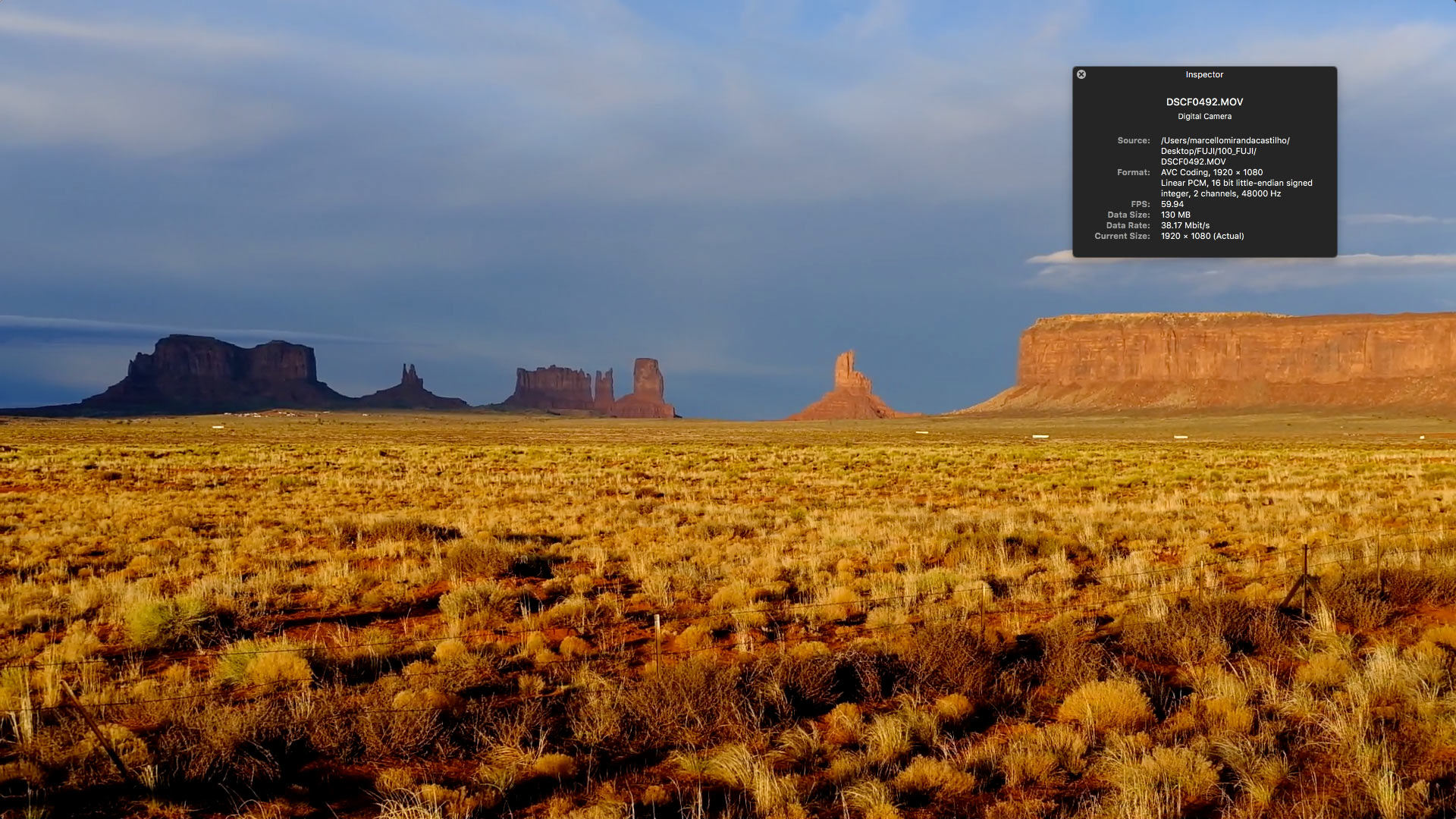
“Monument Valley” with the XF 35mm f/2 R WR; the overly sharpened X-Pro 2 video files, with no image profiles; click for larger.
An unfortunate “extra” on Fuji’s mirrorless cameras has been the video function, badly implement as Canon’s EOS (moiré and aliasing) but with hope for a better future. Although it’s reasonable with 1080P60 max. frame rate and resolution, a 4K mode was announced at launch but mysteriously left out of the commercial X-Pro 2 release. The X-Processor Pro can certainly handle 4K and the UHS-II SD slot has plenty of bandwidth for larger files, so we can only hope for a future firmware update unleashing a more robust video mode on the X-Pro 2. Imagine adapting lenses on it!

Right now there are just three video adjustments: resolution/fps, mic-in volume and remote control scheme. To have a dedicated Movie Settings menu tab for just three lines proves something was cut out prior release. The options for picture profiles merely reflects Fuji’s “film simulation” (we’ll see in a bit), but there’re no controls over sharpening/contrast, resulting in way too electronic images filled with moiré and aliasing. Although the HDMI output is clean, the internal SD card recording bitrate is limited to just 38Mbit/s. It’s a shame it’s so limited, as Fuji’s color science and X-Trans chip are quite good. Let’s hope for a 4K firmware update sooner than later.

“Monument Valley II” with the XF 35mm f/2 R WR em f/5.6 1/180 ISO200.
With a brand new generation of the APS-C X-Trans CMOS III sporting 24.3MP and X-Processo Pro engine, Fujifilm is making bold declarations about the X-Pro 2 image quality. First they say the X-Trans APS-C is equivalent to full frame in terms of resolution, as the pixel area used to measure it (the green one) is 20% larger than Bayer sensors; technically correct, but we’ll see how it works in real life. Then this third generation X-Trans is copper wired, the same technology used on the Sony A6300 Exmor chip, to lower the reading temperature thus reducing noise. And finally, the X-Trans is indeed something different for color and detail reproduction, getting away without a low pass filter for oh-so-sharper files. Does it all work or will it flop like Sigma’s Foveon?

“Monument Valley III” at f/5.6 1/2000 ISO200.
To put it bluntly, allow me to curse: the X-Pro 2 files are fucking awesome! Fuji’s statements about the X-Trans imager indeed are true: besides the APS-C format, the perceived resolution is enormous, for ultra-detailed images made for large prints; the raw files flexibility is immense, with plenty of data to recover shadows and highlights, as good as any Sony Exmor. At high ISOs the noise looks beautiful, organic, as good as full frame sensors. But finally the in-camera JPEG engine far surpasses anything I’ve ever used on a digital camera, with excellent SOOC files rendering Fuji’s most popular films, and a beautiful “grain effect” that perfectly simulates analog negatives.

“#gone” at f/5.6 1/900 ISO200.
High resolution and raw flexibility are fundamental features on digital cameras today. No wonder even the most basic one output 6000×4000 files, and no wonder Sony is being over hyped for its Exmor dynamic range. Being able to see and manipulate high quality details is the very least a camera must deliver, and Fuji’s X-Pro 2 far surpasses any standards I’ve ever seen on the digital era. With the different color array and lack of low pass filters, details pop on screen just like Sigma’s Foveon X3 we saw on the DP Merrills. It’s not every leaf on a tree branch. It’s the insects walking on it. It’s not every brick on a building facade; it’s the crumpling on the curtains inside. The X-Trans resolution is a leap forward to what Bayer sensors offer, and reason the have a Fuji on your kit.

100% crop, besides each brick, it’s possible to see the curtain crumpling inside the window. O_o.
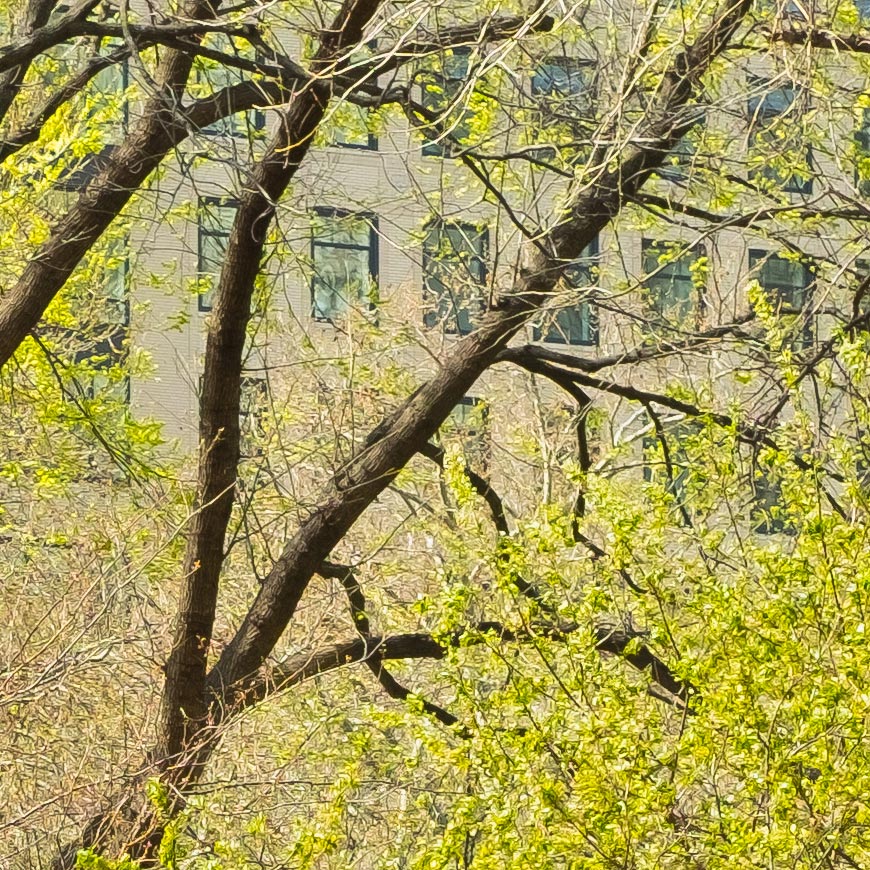
100% crop, besides every branch and leaf, there’s a brick wall behind the tree.

100% crop, fine textures and razor sharp contrast edges are rendered on the X-Trans sensor.
Each uncompressed 50MB raw file also save an impressive amount of data. Nowadays when everyone easily edits their photos through Lightroom sliders, it’s easy to see which sensor record shadows and highlight information, and the X-Pro 2 delivers files as good as any Sony Exmor. Pull Adobe’s Camera Raw slider up to +5 shadow recover to reveal a brand new exposure, with excellent color fidelity and no magenta cast that we’re used to seeing on most Canon’s EOS. Yes, some noise is added to the shadows even ISO200 software renderings, but it’s discreet, clean, grey, certainly unexpected for the APS-C format. Highlights are also preserved and even better the Sony’ Exmor. Blown out skies are nearly impossible with the X-Pro 2, with plenty of exposure latitude to work.
“L Hudson” at f/2 1/60 ISO500; Fuji’s raw shadow recovery is flawless, practically revealing two exposures on a single click.
“Flag” at f/4 1/480 ISO200; expose to your highlights and recover the shadows, with some noise added to the image.
“Death Valley” at f/5.6 1/1500 ISO200; the difference between Classic Chrome and VELVIA simulations, notice the color difference.But the most interesting feature of the X-Pro 2 image quality is how it handles straight out of the camera (SOOC) JPEG files. With an essentially different sensor, Fuji offers an essentially different image profile processing: the simulation of vintage film, coming right out of your digital camera. There are nine options: PROVIA / Standard, for everyday subjects; VELVIA / VIVID, for vibrant colors and high contrast; ASTIA/SOFT, for low contrast and subdue tones; CLASSI CHROME, for neutral colors and low key contrast; PRO Neg. Hi, for high impact portraits; PRO Neg. Std, for low contrast portraits; ACROS, for sharp, high contrast black and white; MONOCHROME, for standard B&W; and SEPIA. It’s not the same as software raw processing: each film has a different color science and the results are subtle, much better than most “Lightroom newbie” attempts. SOOC files:
Besides the film simulation, while most manufacturers painstakingly try to erase noise from their digital files, Fuji embraces it with the so called in-camera “grain effect”. It’s two values, weak or strong, to mimic on JPEG files the same texture as film; much better than any software “add noise” I’ve ever seen. The film simulation + grain effect looks gorgeous (my favorite is VELVIA + weak grain effect), making me question the need to shoot raw and waste time post-processing. If SOOC JPEGs look this good, why waste memory card space? Straight out of camera files:

100% crop, even on JPEG files the noise structure is preserved, while other brands try to eliminate it completely.

100% crop, under exposures look good with the stronger grain effect, saved on the JPEG file.

100% crop, but with plenty of light the strong grain effect can be too much on screen, looking better after printing.
Finally under high ISOs the third generation X-Trans CMOS looks good, but far from full frame performance. Compared to the Sony RX1R, a 24MP full frame compact with no low pass filter, it’s clear on identical exposures how the larger sensor gathers more light and renders more details. “Renders more details” that sound simple, but can make a world of difference on large prints. Fuji’s pixels look bigger the higher the ISO, erasing smaller details. It impresses by maintaining sharp vertical lines over ISO10.000, a consequence to the novelty X-Trans color array.

100% crop, but at closer inspection we can see how midtones get loads of noise; notice the sharp vertical AC lines..
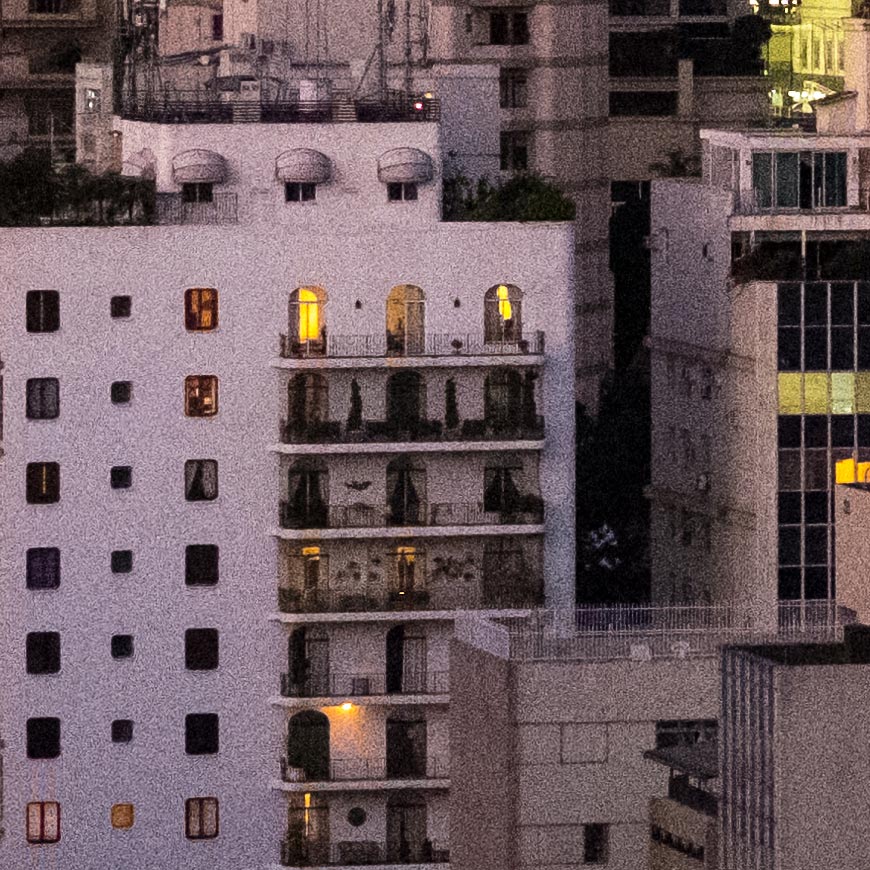
100% crop, so much noise will erase any texture, however the straight vertical lines look sharp.

100% crop, plenty of details on well lit areas, sharp vertical lines.
The Fuji X-Pro 2 arrives as the second generation of the camera that launched the X-Trans technology back in 2012, and Fuji’s future on the overly saturated digital market. They’re ones to blame: three X100, X-T10, X-T1, X-E2, X-A… They all feature the same key differential (newer cameras have a X-Trans CMOS), but the Pro 2 is the only one that deserves the PRO moniker. It’s perfectly built with a weather sealed magnesium body that, although not put to the test, feels robust, easy to use and worth the (body only) US$1699 price tag. It’s the only X camera that keeps the best of both worlds: an interchangeable lens mount with an optical hybrid viewfinder, perfect to solve a problem that mirrorless cameras create: the obligatory Live View. In your face, X-T1…

But the X-Trans CMOS III 24MP APS-C performance seals the deal, with “the best files I’ve ever used”, a seemingly repeated statement on vlog do zack, but natural for a site that tests cameras chronologically. The X-Pro 2 is superior to any APS-C camera, that either use a boring sensor (Sony A6300), an outdated one (Canon T6i); or a poor low light performer (Foveon X3). The X-Pro 2 beats most full frame DSLR: it’s discreet, “photo oriented” and has the personal appeal that you want to use. For a full frame like it, only Leica’s M offers something similar, for at least triple the price. At US$1699 the X-Pro 2 seems expensive, but it isn’t: it’s the best X-Trans ever, with an interchangeable lens mount and an optical viewfinder that dubs as an EVF. It does it all, and does it well. Nothing was left behind, neither the pictures you’re going take with it. Nice shooting!